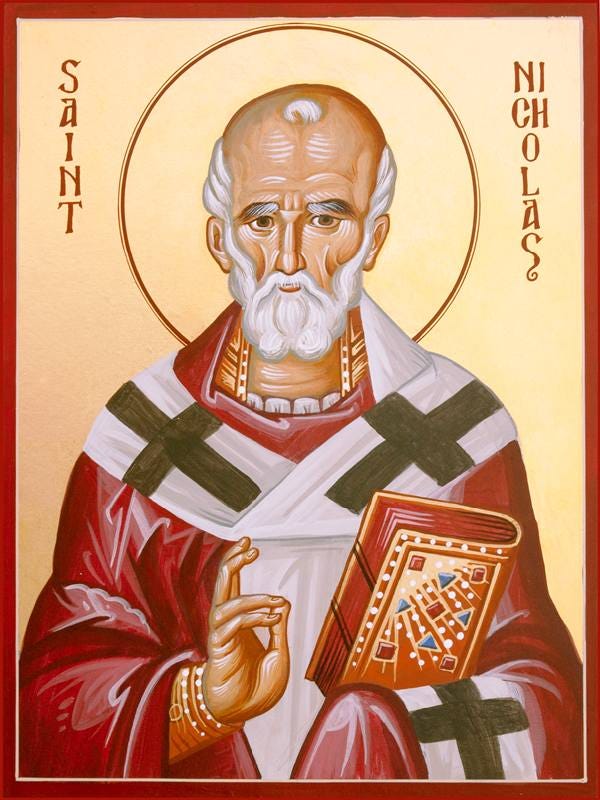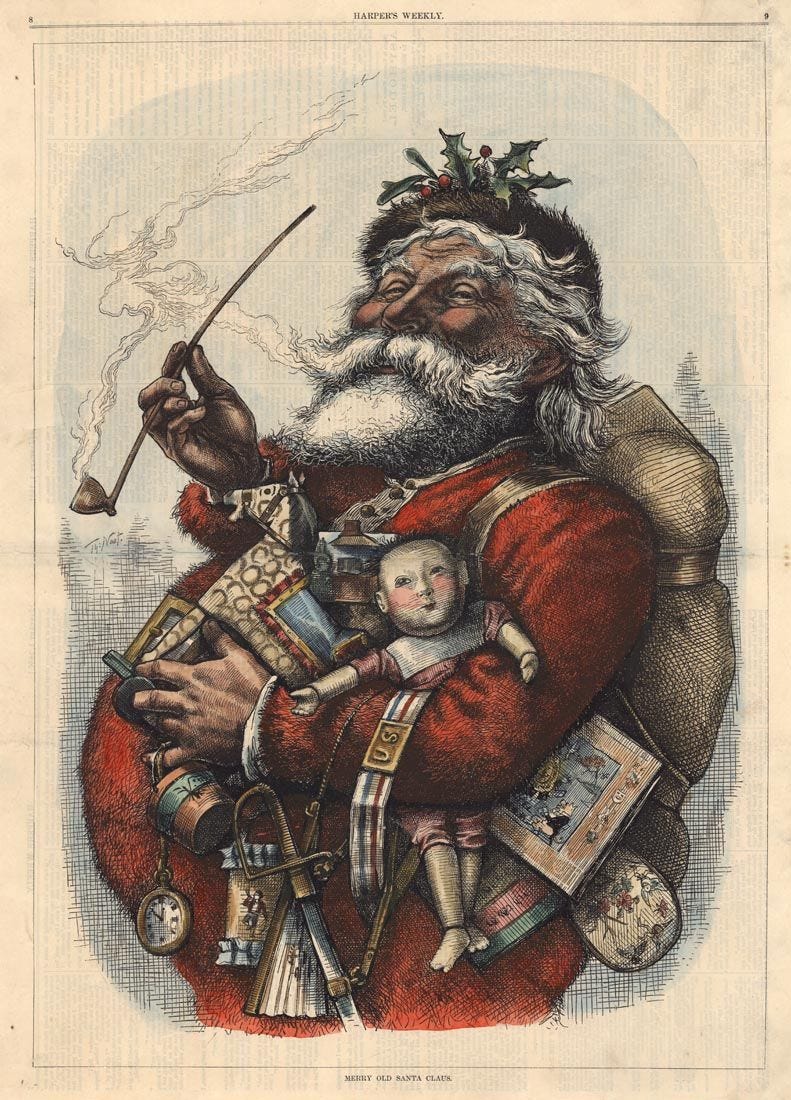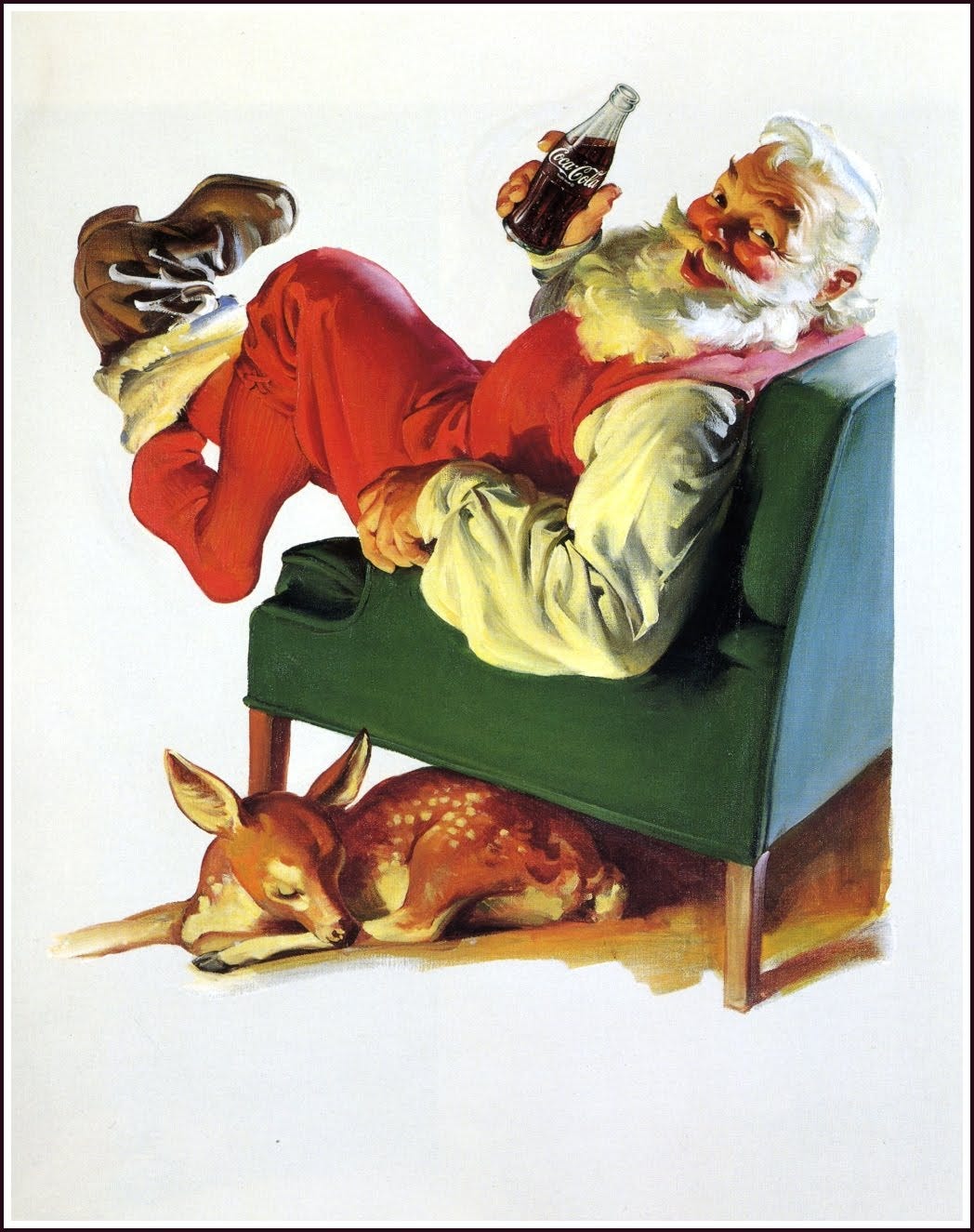Satan Claus
or Why Don’t Santa’s Elves Unionise?
“I love kids jumping on my lap.”
—Joe Biden
Each year it seems the Christmas season begins earlier. Immediately after Halloween Christmas tunes sneak onto the radio while wrapping paper and decorations infiltrate the shelves of stores. Yes, now Christmas is a two month long endeavour. Of course, the signals of when the holiday season starts are located in stores, malls, and shopping centres. The retail sector announces all holidays. The interesting thing about these commercialised holidays is that they have lost their historical roots thus, their cultural meaning. Shopping is the ubiquitous holiday ritual under late stage capitalism. The only difference between holidays is the colour scheme. Yet if all holidays are consumptive rituals devoid of all deeper meaning, Christmas is the one par excellence. The Christmas shopping orgies are done not in the name of the purported birthday boy (the exact date of Christ’s birth is unknown), but in the name of Santa Claus. Who is this inimitable Santa, we might ask and where does he come from? What deeper resonances might the Santa myth have; what deeper consequences? Given that the study of the historical origins of Santa Claus and his modern day uses could result in a book length piece, I will merely give a condensed history with a few observations of my own.
(Icon of Saint Nicholas)
Much of the mythos surrounding Santa Claus comes from the story of Saint Nicholas, a Greek Christian bishop from the fourth century. From a wealthy background, Saint Nicholas was known for his generosity and his gifts to the poor. One of the most well known stories about him tells how he provided the three daughters of a poor man with dowries so the girls would not have to resort to prostitution. Purportedly, Saint Nicholas delivered the money by tossing bags of gold through the window of the poor man’s house, which were said to have landed on a pile of stockings. This spawned the stocking tradition, which was practiced on Saint Nicholas day, December sixth. A variant of the story replaces the bags of money with three golden balls which is why oranges were the traditional gift on Saint Nicholas’ day.
Later in time the tradition of Father Christmas arose in England, which dates back to the sixteenth century. At this time, England no longer celebrated Saint Nicholas’ day. Martin Luther played a small role in the modern formation of Christmas, as it was his suggestion to move the giving of gifts on Saint Nicholas’ day to December twenty-fifth with the hope that giving children gifts on Christmas rather than Saints’ days would interest children in Christ more so than saints. Interestingly, the figure of Father Christmas experienced a revival during the Victorian Era. Thus it seems that Father Christmas (dating from the sixteenth century) and the giving of gifts on Christmas are linked to the development of capitalism and its religious movement par excellence; protestantism (per Martin Luther). (However, I must add that Martin Luther was critical of excessive wealth and greed and would no doubt be quite disturbed at what Christmas has become.)
The figures of Father Christmas and Saint Nicholas culturally merged to create the modern Santa Claus, incorporating Dutch traditions in as well. (Santa Claus is a phonetic derivation of the Dutch “Sinterklaas”, itself a derivation of Saint Nicholas). Washington Irving is known to have Anglicised the term in his book History of New York. Irving described this nascent Santa Claus as a sailor with a green coat rather than a bishop per Saint Nicholas with the aim of mocking the Dutch culture of the time.
(Thomas Nast Santa)
In the nineteenth century, an anonymous poem was published about “Santeclaus” and his reindeer sleigh. A Visit From Saint Nicholas also appeared, which is popular to this day, although the claim of authorship by Clement Moore is now disputed. A cartoon of Santa Claus draped in an American flag appeared on the cover of the 1863 Harper’s Weekly. It was drawn by Thomas Nast who was responsible for many Santa cartoons. It is speculated that Nast also began the North Pole myth. Interestingly, both Irving’s and Moore’s literary works on Santa Claus were written with a purpose. Both authors disapproved of the raucous celebrations in the streets that were common on Christmas in those days. They contributed to the creation of Christmas as a holiday of home, family, and hearth. The Victorian Era Santa Claus very much bespoke the bourgeois values of the time, with an emphasis on domesticity.
(Coca-Cola’s Santa Claus)
In the twentieth century, L. Frank Baum wrote The Life and Adventures of Santa Claus which was published in 1902. A modern fairytale of sorts, the story traces Santa from his infancy to how he gained immortality. The Coca-Cola company used illustrations of Santa Claus drawn by Haddon Sundblom for Christmas advertising in the 1930s. This gave birth to the legend that Santa was an invention of the Coca-Cola company and was depicted in white and red because they are Coca-Cola’s colours. In fact, Santa Claus attired in white and red appeared much earlier. The Coca-Cola company was not even the first beverage company to use Santa Claus for advertising purposes. In 1915, White Rock Beverages used a monochromatic Santa in mineral water advertisements and in the 1920s used him in colour for drink mixer ads. Of course, the Coca-Cola company (now a monolithic corporation) has capitalised on its conscious and unconscious association with Santa Claus, adorning its ugly face with comforting Christmas kitsch.
(Santa zoom call advertisement)
The first department store Santa was devised by the entrepreneur David Lewis. Santa Claus debuted at Lewis’ store in Liverpool, England in 1879. Department store Santas spread to Australia and the United States in the 1890s. Mall Santas are prevalent to this day and during covid children could have a zoom call with Santa. The fact that Santa is a frequenter of malls and department stores during the holiday season says much about his present day purpose. (No pun intended.) Located in the midst of an overstimulating environment packed with enticing consumer goods, a mall Santa is far more likely to exact a lengthy wish list than writing him from home. The pedophiliac undertones of a man who has small children sitting on his lap all day is concealed behind a mask of grandfatherly warmth. Perhaps this is part of why Santa Claus is so appealing to many children; he symbolises the father or grandfather who is mostly or entirely absent from their lives. The benevolent patriarch, the embodiment of caring authority. Yet Santa Claus also normalises constant surveillance. “He sees you when you’re sleeping, he knows when you’re awake…” He is omnipresent and always has a watchful eye, careful to notice any misdeeds. Santa Claus ruptures the private sphere, invading the home and monitoring the children. Perhaps this is why Santa seems sinister to many. The stalker pedophile who has candy waiting in the car…
Without going too deep into the manifold psychological implications around Santa Claus let us return to his primary function in capitalist society: targeting children to pressure their parents into buying things and normalising consumer society. Much like eye level candy at most store check out lines, Santa culture catches the kids’ attention and they exert guilt on their parents, unconsciously furthering corporate interests. Most parents want to make their children happy and see them fit in with their peers. Often times branded toys and products are class signifiers and children who don’t have them will feel excluded and inadequate, not to mention be ostracised. Being inundated with advertising, peer pressure, and the desire to socially conform, what children want for Christmas is shaped by the society they live in. The United States being a late stage capitalist empire with historical roots in puritanism and genocide, the toy demands are often quite *problematic*. In any given society the toys children play with normalise said society and help them find their proper role in it. Hence how many children’s toys these days involve shopping and glorification of the U. S. military. As horrendous as the experience is, going to a toy store is a fascinating sociological study. Funnily enough, the toys children are told to want are often more fun in theory than practice and the kids end up enjoying the box for much longer than the toy. I am young enough to vividly remember being a kid at Christmas, and I can attest to the fact that the flashy, expensive toys are often no fun at all after two uses. Santa Claus culture serves to normalise enlightened self interest. Children are told to be good all year so at Christmas they will get all the stuff they could possibly want. Instead of children being taught to behave well because it makes society better for everyone, they are taught to hold in their bad behaviour so they can get lots of loot for them alone to enjoy. This individualistic mentality moulds children to fit into a society of ladder climbing, secret perversions, and exploitation of others. For after all, most children struggle to behave perfectly all year and commit their transgressions behind closed doors. Fourier once said that a coercive regime causes deception and the case of conditional gift giving is no exception.
Parents are socially motivated to purchase for their offspring and often times enjoy deceiving them about the facticity of Santa’s existence. Many adults long for the magical Christmases past when they were bestowed with wonderful gifts without having to work shit jobs to pay for them. Not to mention kitsch nostalgia, which is a major part of American Christmas culture. In a way, Santa is emblematic of the globalisation (Americanisation) of the world. Consistent with much of North American culture he is a hodge podge of Christian and Pagan traditions and myths from the global North. In Santa, it ossifies into a benevolent patriarch who is exploiting elves at the North Pole like the most ruthless of capitalists. Santa Claus sits atop the whole globe, travelling everywhere in one night, with dominion and surveillance powers much akin the U. S. empire. (*Sarcasm* Did Santa initiate the fall of Assad in Syria? There are free markets in Syria now, so that would definitely benefit Uncle Sam. Oops, I mean Old Saint Nick. Though I don’t know, Syrian Christians are being brutally killed, and Christmas just got banned, so... )
Economically the holiday season is extremely important. Starting with Black Friday, the mad dash of spending serves to off load surplus product and avert a crisis in overproduction. As the saying goes, on Black Friday businesses move from the red to the black. The banks are fond of Christmas shopping as well, I’m sure. How many people strain their credit cards and go into large amounts of debt over the holidays? Santa Claus is not an innocent figure and the myths and rituals surrounding him serve to normalise capitalist society from a young age. Of course a Father Christmas/Santa Claus figure doesn’t have to take such an odious form but, inevitably the myths that evolve to form the superstructure of a specific society mirror the socio-economic formation of the base. Thus American Santa Claus is a figure which dissolves cultural meaning in the capitalist imperialist melting pot furthering neoliberal economic policies and globalisation.
I think it is of symbolic value how the modern day version of the Saint Nicholas/Father Christmas myth has explained the supply of his gifts by the use of elf labour. Santa Claus doesn’t make the toys himself, or make cookies himself, or fix his pants himself. Mrs. Claus and the elves do those things. The only thing Santa does is deliver the goods. As Jesse Welles noted in a humorous song, “Santa Claus is Amazon”. It is true, though. Just like Amazon, Santa merely delivers the goods yet he receives all the credit. Thus on some level the Santa Claus myth normalises hyper-exploitation. (And since according to L. Frank Baum’s version of his origins, he wasn’t born on the North Pole he is also a colonialist, leeching off the indigenous population of elves…)
All in all, I must sound like a terrible Scrooge. However, my point is not to discourage people from enjoying themselves over the holiday season. Rather it is to plant a seed. The next time you see a grinning Santa Claus in a store think of the masses of people ravaged by Western imperialism. Think of the growing homeless population in the United States. Think of why the small amount of time you have off of work should be spent buying gifts out of obligation and under duress. Think about how much capitalism pollutes every sphere with profit motive. Happy holidays to all my readers and hopefully the new year will be less horrific for the global South (though unfortunately I doubt it). Soon I will be publishing a comprehensive piece addressing something important, so keep your eyes peeled.
“Merry Christmas
I hope you have a white one, but for me, it’s blue
Blue Christmas, that’s the way you see it when you're feeling blue
Blue Xmas, when you’re blue at Christmastime you see right through
All the waste, all the sham, all the haste
And plain old bad taste
Sidewalk Santy Clauses are much, much, much too thin
They’re wearing fancy rented costumes, false beards and big fat phony grins
And nearly everybody’s standing round holding out their empty hand or tin cup
Gimme, gimme, gimme, gimmе, gimme, gimme, gimme
Fill my stocking up
All thе way up
It’s a time when the greedy give a dime to the needy
Blue Christmas, all the paper, tinsel and the fal-de-ral
Blue Xmas, people trading gifts that matter not at all
What I call, fal-de-ral
Bitter gall, fal-de-ral
Lots of hungry, homeless children in your own backyards
While you’re very, very busy addressing
Twenty zillion Christmas cards
Now, Yuletide is the season to receive and oh, to give and ah, to share
But all you December do-gooders rush around and rant and rave and loudly blare
Merry Christmas
I hope yours is a bright one, but for me, it’s blue.”
—Miles Davis, Blue Xmas (To Whom It May Concern)
Further reading:
on Mrs. Claus https://substack.com/inbox/post/153015768
xmas and capitalism https://westwoodminute.town.news/g/westwood-ma/n/136643/history-christmas-tree-legends-family-and-capitalism
https://crescent.icit-digital.org/articles/santa-claus-in-the-service-of-western-capitalism
Santa’s colours https://www.bbc.com/news/business-46619012
songs






Execellent piece. I didn't know most of that. I do recall waking up one Christmas to the realisation that the Santa image with the fat belly and rosey cheeks and bellowing laugh was as far as you could get from the image of the emaciated mortified Christ who died for our sins.
I was also intrigued by this notion of arrival via the chimney. Distinctly Freudian. And it makes the surveillance angle even creepier.
Pity the children whose parents do the stupid elf on the shelf thing🙄